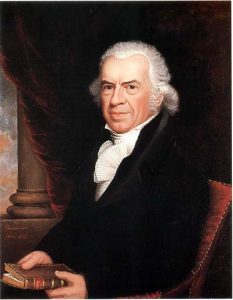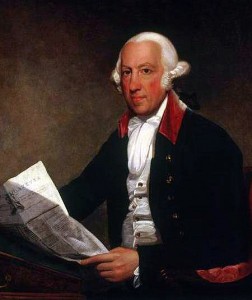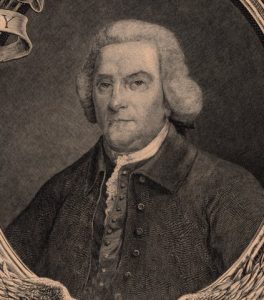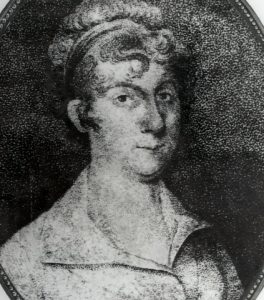For Americans in the Revolutionary era, newspapers provided a major source of information about events related to the conflict with Great Britain. The people who produced these publications played a key role in getting the news out because they believed it was important for people to know what was happening. They also strongly supported their side of the conflict (while most printers supported the American side, some did stand with the British). The printers played a variety of roles beyond just printing their own paper: they provided information for other parts of the country through the pieces they printed, and served in a variety of capacities in their communities beyond their print shop. They also experienced the American Revolution in a variety of ways. Making a list of the ten most important printers is difficult if not impossible, but discussed below are the ten I think had the biggest impact.
John Holt
John Holt originally partnered with James Parker in publishing the New York Gazette; or the Weekly Post-Boy in 1760. When Parker retired in 1762, Holt continued the business for a few years. He set up on his own in 1766, but he continued the newspaper. He changed the name to the New-York Journal; or General Advertiser in October 1766. Holt developed a reputation for being a strong Whig who advocated for the rights of the colonies. He soon became the most important printer outside of Boston because of his coverage of the fight between the colonies and Great Britain. He worked with the Sons of Liberty to spread their materials throughout the colonies. For example, from 1768 to 1769 Holt published the “Journal of Occurrences” about events in Boston. These pieces and many others that Holt published during the Revolution were picked up by other printers, particularly in the colonies south of New York. Holt thus became an essential link in the spread of Patriot ideas throughout the colonies. Holt is also a good example of how tough the war could be for the newspaper printers. He left New York City just before the British arrived in 1776 and fled to New Haven, Connecticut. He then moved to Kingston, New York, in 1777 and revived the Journal. He fled from Kingston just before the British burned the town. He then went to Poughkeepsie, New York, and continued the newspaper. Each time Holt moved, he lost his property and sometimes most of his belongings. But he kept trying to publish the Journal in order to continue to get the word out about what was going on in the fight with Great Britain. Although not the most famous printer of the Revolution, Holt may be the most important because he never stopped working to keep people throughout the colonies informed and encouraged about how the fight was going.
Benjamin Edes
Benjamin Edes printed the Boston Gazette in partnership with John Gill from April 1755 to June 1775 and by himself from that point until September 1798. During the 1760s and early 1770s, he printed much of the news that helped produce the American Revolution. The Boston Gazette served as the primary mouthpiece for Samuel Adams, James Otis, and others, which meant that Edes’s newspaper was a major source of information about the conflict with Great Britain for all the other newspapers printed in the American colonies. But his efforts went beyond just printing what others had written. Edes himself was a strong supporter of the Revolution, becoming more vocal in his protests of British actions following the adoption of the Stamp Act. In 1768-1769, it is thought that he worked with Samuel Adams to produce the “Journal of Occurrences” which related the atrocities committed by the British officials in Boston. The “Journal” was very polemical in its descriptions and thus functioned as propaganda designed to sway the colonies to join Boston in opposing British authorities. When the Tea Act made the situation even worse, Edes printed protests as well as engaging in the planning and activities that led up to the Boston Tea Party. Following the battles of Lexington and Concord, Edes fled Boston to Watertown, where he continued to publish the Gazette in an effort to make sure that the people knew as much as possible about events in Massachusetts and elsewhere. He returned to Boston after the British evacuated and continued his newspaper. In his History of Printing in America, Isaiah Thomas praised Edes as the printer who provided the strongest support for the fight for independence.

Isaiah Thomas
Isaiah Thomas founded the Massachusetts Spy in Boston in July 1770 in partnership with Zachariah Fowle. The partnership ended in October, but Thomas continued to publish the newspaper. The Spy supported the Patriot cause from the very beginning and regularly printed essays, both as pamphlets and in the newspaper, which supported the rights of the colonists in the face of British restrictions. Beginning in July 1774, Thomas joined others to revive the “Join or Die” drawing originally developed by Benjamin Franklin in 1754. The Spy’s masthead included a snake fighting the dragon of Great Britain and called on the colonies to “Join or Die.” British authorities tried several times to shut Thomas and his paper down, but never succeeded in doing so. Thomas realized, before many others, that the fight between the colonies and the mother country was soon to become a shooting war. He moved his press to Worcester, Massachusetts, shortly before the battles at Lexington and Concord. He actually witnessed the first shots at Lexington and reported about them in the Spy. He continued publication of the Spy throughout the war and sought to use the pages of his newspaper to inform and encourage his readers about the war with Great Britain. Thomas is also important because he saved the newspapers he received from other printers all over the British colonies. Today, this group of newspapers provides the core of the collections at the American Antiquarian Society in Worcester, Massachusetts, a major research center for anyone interested in the press during the American Revolution. So, Thomas not only reported on what he saw at the time, but he also worked to make sure that future generations would be able to understand what happened as well.

James Rivington
James Rivington is often considered to be the best printer to have worked during the Revolutionary Era. He first published the New-York Gazetteer in April 1773. At first, Rivington tried to be objective and present both sides of the conflict, but this did not last long; he increasingly spoke out in support of the British government. He made the Patriots so angry that they tried to shut down his operation on two different occasions in 1775. They succeeded the second time, destroying his press and melting down his type to make bullets. Rivington soon left New York for England. He returned in 1777 and once more published a newspaper, first called Rivington’s New York Loyal Gazette and then the Royal Gazette. These newspapers were excellent productions and included the most news from other countries of any papers printed at that time. Rivington became famous as the most vocal printer who supported the British in their fight with the colonies. He continually printed rumors about the Patriots, earning his paper the nickname of “Rivington’s Lying Gazette.” When the war ended, most people assumed that Rivington would be arrested for his activities but that did not happen. Rumors began to spread that Rivington had been a spy for General George Washington. There is evidence to support this assertion, but it doesn’t really matter. He was a very influential Loyalist printer, no matter which side he was actually supporting. [For more on Rivington’s rumored espionage, read “James Rivington: King’s Printer and Patriot Spy?” by Todd Andrlik]

John Dunlap
John Dunlap began publishing the Pennsylvania Packet in 1771 and continued it until 1795. Dunlap was a good businessman and did well in his printing business. He became the printer for the Continental Congress in 1776. As a result of this position, he became the first printer to produce copies of the Declaration of Independence. Following its adoption on July 4, Dunlap printed about 200 broadsides of the Declaration which were the first printed versions of the document. This action alone would have made Dunlap a very important printer in the Revolutionary era, but he also produced most of the information printed about the actions of the Continental Congress. Coverage was limited because the Congress hesitated to quickly publicize their actions too much, particularly prior to voting to break away from Great Britain. The Continental Congress did provide for the publication of their journals and Dunlap fulfilled this assignment from 1777 to 1779 (from Lancaster, Pennsylvania, while the British occupied Philadelphia from September 1777 to July 1778). Dunlap also served in the militia for the city of Philadelphia and fought in the battles of Trenton and Princeton. He was one of the few printers to serve the Revolutionary cause in this way. After the end of the Revolution in 1783, Dunlap continued publishing his newspaper and turned it into a daily in 1784, the North American and United States Gazette. Although not the country’s first attempt at a daily newspaper, Dunlap’s paper was the first successful daily produced in the United States and thus extended his impact beyond the Revolution.
Peter Timothy
Peter Timothy published the South-Carolina Gazette from 1740 to 1780. He took over the printing business from his mother Elizabeth Timothy, who had run it following the death of her husband Lewis in 1738. The South-Carolina Gazette was the leading paper in Charleston throughout this era. Peter Timothy worked hard to publish a good newspaper that kept his readers informed. Prior to the late 1760s, Timothy presented a neutral stance in the growing fight between the colonies and Great Britain. Timothy personally appeared to be pro-American, but he believed that the newspaper should not take sides. That outlook started to change when the British adopted the Stamp Act with its taxes on advertisements and newspapers. Timothy increasingly commented on the actions of the British, but both sides continued to criticize him because he did not come down strongly for one side or the other. He supported public protests against the Stamp Act which angered Loyalists, but he also did not work hard to prevent the use of stamps in Charleston which made the Patriots mad at him. During the 1770s, Timothy grew in his support of the Patriot side, both in the pages of his newspaper and his activities. He served in several groups working against British authority prior to the outbreak of fighting and he served as secretary of the general assembly after independence was declared. He did not flee Charleston when the British occupied the city in 1780. He was imprisoned by British authorities in Saint Augustine and his newspaper ceased publication at that time. But his impact had already been made because his newspaper had been a major source of information for people in South Carolina and the other Southern colonies.

Hugh Gaine
Hugh Gaine’s career reflects some of the issues faced by printers during the American Revolution. He received great criticism from British authorities and Patriot leaders because he seemed to not be able to make up his mind which side to support. He bounced back and forth, depending on what issue was under consideration and who was in control. Gaine published his newspaper, the New-York Mercury, for thirty-one years. Founded in 1752, he changed the name to the New-York Gazette and the Weekly Mercury in 1768. The paper kept this name until it ceased publication in 1783. Gaine was a successful printer in New York, but the growing fight with Great Britain produced many problems. He opposed the taxes passed by the British, including the Stamp Act and the Townshend Acts. He also supported the boycott of British goods in an effort to get the taxes repealed. But when all the taxes except the one on tea were repealed, he called for an end to the boycott. During the next several years, he printed little political news in the pages of his newspaper. When relations worsened following the Boston Tea Party, Gaine urged everyone to avoid violence and he advocated working until a deal could be reached with Great Britain. His failure to fully support the boycott efforts of the Patriots resulted in him being branded an enemy by militant Whigs. Gaine sided with the Whigs following Lexington and Concord; he fled to Newark, New Jersey, when the British invaded New York in September 1776. He returned to New York in November and then supported the British. But the British did not trust him any more than the Patriots had because he seemed to have been wishy-washy in deciding which side to support. Gaine has ultimately been labeled a Loyalist printer because of his support at times of the British, but his struggle with which side to support is important because it reflects the complications that printers faced in choosing allegiance while also maintaining their business.

Mary Katherine Goddard
Mary Katherine Goddard was one of a handful of women printers in the 1700s. Her brother William had founded The Maryland Journal in Baltimore in 1773. She took control of the newspaper in 1774 when her brother began to focus his attention on developing the postal system, and the newspaper was published under her name from that time on. Goddard successfully produced the paper for the next 10 years, providing news and information for the people in Baltimore and surrounding areas in Maryland. Even though supplies of paper and ink were difficult to come by during the Revolution, Goddard managed to keep producing the newspaper on a regular basis. She strongly supported the Revolutionary cause and printed news about the war as often as possible. The Maryland Journal carried the Declaration of Independence on July 10, 1776, less than a week after its adoption. Goddard also volunteered her press to the Continental Congress when they wanted to make sure the Declaration of Independence was distributed widely throughout the colonies. Her broadside of the Declaration, appearing on January 18, 1777, was the second one produced and the first one to contain the names of all the signers. Mary Katherine Goddard received much attention as a printer during her lifetime because she was independent and was not working to help her husband (she never married). Thus, her contribution to the history of Revolutionary journalism goes beyond the materials she printed to include her impact on attitudes of people about the role of women in American society.
John Carter
John Carter published the Providence Gazette from 1767 to 1814. It was the only newspaper in Providence before 1775. Carter learned the printing trade as an apprentice to Benjamin Franklin and David Hall in Philadelphia. He moved to Providence in 1767, where he entered a partnership with Sarah Goddard. She withdrew from the partnership just over a year later, but Carter continued the business. His newspaper was a strong supporter of the Patriot cause throughout the Revolution and he sought to use the pages of his weekly production to encourage others to join and support the cause as well. Carter served on the local Committee of Correspondence during the Revolution. His willingness and desire to carry out this assignment reflects how important he thought it was for people to be informed about the events taking place in the conflict between the colonies and Great Britain. He printed what news reports he could get about how the fight was going. When the fighting began in Massachusetts, Carter urged the people to unite together to face the British threat. He believed it was important for him to work hard at keeping the people informed about what was going on. Carter actually encouraged Colonel Joseph Trumbull to help with the problem of acquiring good information by sending accurate reports for publication whenever possible. Printing the Providence Gazette was obviously a major part of how Carter made his money, but he also saw the newspaper as an important mechanism for encouraging people in Rhode Island to get involved in what he perceived as the important fight for freedom.
Alexander Purdie
Alexander Purdie was an important printer in Williamsburg, Virginia. He became the publisher of the original Virginia Gazette following the death of his employer, Joseph Royle, in 1766. He partnered with John Dixon until 1774 when Dixon entered a new partnership with William Hunter. There was already another newspaper titled Virginia Gazette and Purdie began a third one following the dissolution of his partnership with Dixon. He continued to print this newspaper until his death in 1779. Purdie saw his newspaper as a tool to help the citizens of Virginia work to protect their rights and to improve their lives. This was clearly seen in the newspaper’s motto, “Always for Liberty and the Public Good.” Purdie was a strong supporter of the Patriots, which was reflected in the articles he printed. He used the masthead of his newspaper to encourage support for the Patriot cause. He originally included the phrases “Thirteen United Colonies” and “United we stand, divided we fall” at the top of the front page. He later replaced this with a coiled snake and the motto “Don’t tread on me.” Purdie used the pages of his Virginia Gazette to keep his readers informed about the fight for independence and freedom and thus helped engage them in the war when the fighting was far away and urged them to participate when the fighting got close to home.
[For further reading, Isaiah Thomas’s The History of Printing in America is an excellent source that is widely available in various reprint editions.]










7 Comments
What a strange coincidence. Just a couple of days ago I ordered a copy of Isaiah Thomas’ book. Now, I look forward to reading it even more than before. Thank you!
Thanks for this important contribution, Carol. I’ve said it before and I’ll say it again: Newspaper printers deserve a great deal of credit for their roles in the Revolution. Modern historians and journalists give a great deal of credit to social media for helping to fuel and organize the Arab Spring rebellions, so I’m surprised the stewards of the only mass media during the American Revolution don’t receive more attention. Many historians agree: Without newspapers there would have been no American Revolution. And the importance of newspapers is well documented by the Founding Fathers themselves. Dr. Benjamin Rush said during the war that a newspaper was “equal to at least two regiments.” If any soldier was worth two regiments during the Revolution, he’d surely have statues and schools named after him today. Then and now, historians have recognized the tremendous power of the press to launch and sustain the American Revolution as well as affect its outcome, so it seems appropriate to also give credit to those behind the press who selected the sources, and typeset and printed the pages, often in the face of life-threatening danger.
Another good topic. Yet the trick with reading Revolutionary War era newspapers (I think) is deciphering what is true and what is not. Stories of atrocities, or Hessians ravishing maidens, and so on, may be true, or may not be. Battle reports may be exaggerated. It would be worth an entire book – if it has not already been written – to analyse colonial newspapers for their veracity. For example, how many times did newspapers of the day (and books today) use the word “massacre” to describe events in which Americans won, versus events when the British won.
The London Chronicle published reports of George Washington’s death during the war. It also reported his capture in 1777 and his resignation in 1778. And while a phony battle or two did get printed, it shouldn’t detract from the surprising accuracy of newspapers of the period.
Newspaper printers valued accuracy and often added disclaimers about unreliable sources. They needed to maintain the integrity of their papers if they were going to continue attracting subscribers and advertisers. In the London Chronicle, dubious news always seemed to always appear on the back page, which may have been known as the gossip section then. Similar to the chaos of big breaking news and war reportage today, 18th century stories developed with time, becoming more accurate as printers hurried to piece together bits of oral, manuscript and printed intelligence to corroborate accounts for their readers.
In my humble and self-promoting opinion, the best book for analyzing colonial newspapers for their veracity is my own, Reporting the Revolutionary War (Sourcebooks, 2012). Thanks for so nicely teeing up that plug! Not only does my book contain hundreds of high resolution color images of the original Revolution-era newspapers, allowing readers to experience the Revolution as the colonists did and play the role of historian, but it also contains modern analysis by 37 top historians and experts. I asked each contributor to dissect the newspapers and, more importantly, to play the role of referee, calling fouls on any errors or omissions they came across. The contributors to the book often commented on just how accurate the period news reports were about their respective events.
Todd is being too modest. His book Reporting the Revolutionary War is one of the most remarkable books ever compiled. Not only is it artistically stunning but the scholarship and expert commentary (much supplied by Todd) is outstanding. It truly is a must-read. In the interests of full disclosure I wrote one of the articles. However, it is just a small part of a truly exceptional book. When it comes to newspapers Todd is the expert.
Wow, Hugh. Thanks! Where do I send the check? 🙂 I should also point out that Carol Sue Humphrey, a leading authority on early newspapers and author of this “Top 10 Printers” article, is one of the contributors to Reporting the Revolutionary War along with you and several other Journal of the American Revolution writers: Ray Raphael, J. L. Bell, Don N. Hagist, Benjamin L. Carp, Thomas Fleming, Benjamin H. Irvin, Jim Piecuch, etc.
True that, Hugh, on Todd’s “Reporting the Revolutionary War” book!